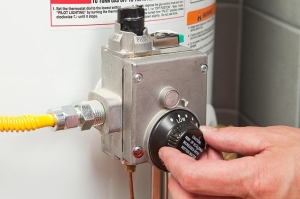
Water heaters use about 25 percent of the energy consumed by an average American household, making them the second largest energy user in the home, after space heating.
Standby losses are those related to keeping the hot water standing by in a tank or keeping your water heater ready to fire again at a moment’s notice. Electric and gas water heaters both have losses through the tank, but gas water heaters of the same capacity actually have a bit more loss. Why? Because they have more surface area. An electric water heater loses heat through the sides, bottom, and top. A natural gas water heater loses heat in those places and also through the exhaust flue pipe that goes right up through the middle of the tank. Fifteen to thirty percent of the energy consumed by a standard water heater goes to keeping the water hot while it’s not being used! A water heater can fire up to 3 times a day when it is not being used.
A water heater timer is a great energy saver. Besides standby heat loss reduction, water heater timers save money and energy in another way. A timer can save money because it rations the amount of available hot water, and consumption drops. When a timer is being used, consumption drops simply because replenished hot water is not available except at precisely scheduled times. When the timer is no longer used, the consumption will increase, and this added consumption means more energy use. A big factor for saving money with a water heater is to reduce consumption.
Another less practical way to cut Standby heat loss is to install a tankless water heater. Demand heaters (also called tankless or instantaneous heaters) reduce standby loss by heating water only as it flows through the heater on its way to a faucet actually in use. Demand heaters have their efficiency drawbacks as well. Their initial cost is high, in a retrofit; the gas line will require upgrading and venting will have to be re-configured. Annual maintenance is required, and the number of fixtures used at one time is limited. Some gas demand heaters have pilot lights, limiting their savings to 5-10 percent over a standard water heater. Electric demand heaters require so much power to instantaneously heat water at a reasonable flow and temperature rise, they can actually be the most expensive type of water heater to operate. Applications for electric demand heaters are best limited to small flow, low temperature uses like bathroom sinks at the far end of the house from the main water heater.

One Comment